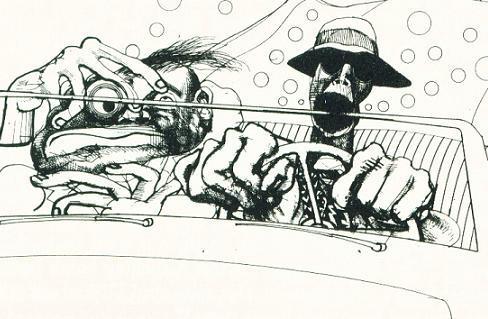 |
| $48.8 million "Dustheads" - Does Ralph Steadman get a cut? |
NEW YORK — A Jean-Michel Basquiat (zhahn mee-SHEHL' BAH'-skee-aht) painting has set a new auction record for the graffiti artist at a sale of postwar and contemporary art in New York.
Christie's says "Dustheads" sold for $48.8 million on Wednesday.
 |
| Mandelbrot Set hairdo |
Jean-Michel Basquiat (December 22, 1960 – August 12, 1988) was an American artist.[1] He began as an obscure graffiti artist in New York City in the late 1970s and evolved into an acclaimed Neo-expressionist and Primitivist painter by the 1980s.
Throughout his career Basquiat focused on "suggestive dichotomies," such as wealth versus poverty, integration versus segregation, and inner versus outer experience.[2] Basquiat's art utilized a synergy of appropriation, poetry, drawing and painting, which married text and image, abstraction and figuration, and historical information mixed with contemporary critique.[3]
Utilizing social commentary as a "springboard to deeper truths about the individual",[2] Basquiat's paintings also attacked power structures and systems of racism, while his poetics were acutely political and direct in their criticism of colonialism and support for class struggle.[3] ...
Considering that some plutocrat has $48.8 million to spend on what looks like a colorized drawing from Fear and Loathing in Las Vegas, I'd say the class struggle has been won. As Paul McCartney and Stevie Wonder sang:
Plutocracy and Diversity
Live together in perfect harmony
P.S. One under-reported aspect of art fame is the advantage of being gay for pay, like the bisexual Basquiat, who had been a teenage hustler. For example, Paul Johnson's description of how the heterosexually oriented Picasso had boosted his career by obliging gay critics, collectors, and dealers is eye-opening.
It's a who-you-know business. I remember going to see a spectacular exhibit of Rene Magritte surrealist paintings in 1976 in a Quonset hut in the parking lot of the Rice football stadium. Nobody was there. Magritte was a Belgian commercial illustrator in Brussels who was beloved by commercial artists in the advertising industry. For example, in 1973, Sports Illustrated's preview of the U.S. Open golf tournament at Oakmont consisted of Donald Moss's paintings of Oakmont's famous sand traps in the style of Magritte:
But the provincial Magritte didn't fit into the Narrative of high art history easily, so he had this curious kind of non-museum fame in the 1970s.
Two decades later, though, I paid to hear a packed lecture on Magritte at the Art Institute of Chicago before seeing a sold out exhibit of pretty much the same Magritte paintings. I asked the art historian after her lecture, if, considering how lightly regarded Magritte was back as recently as the 1970s, someday the Art Institute would host a giant M.C. Escher exhibit? She was taken aback, then replied that recent scholarship established that Magritte had spent 1927-1930 in Paris hanging out with famous painters who influenced him. Then she stopped. Finally, she said, "I don't want to make it sound like art history is all about who you know ..." Then she stopped again with an alarmed look on her face.
The point is that discovery of Magritte's Paris interlude made it easier for critics to plug Magritte into the Narrative. I can understand the appeal of that. I like narratives of cause and effect, of who influenced whom.
Basquiat plugs in very easily: Andy Warhol was infatuated with Basquiat.
That doesn't mean Basquiat was talentless. He was no doubt far better at painting Ralph Steadman-style pictures than anybody else plugged into Warhold World, and maybe better than Steadman. Almost everybody who becomes famous is quite good at what they do. But, there's a lot of talent in this world.








0 comments:
Post a Comment